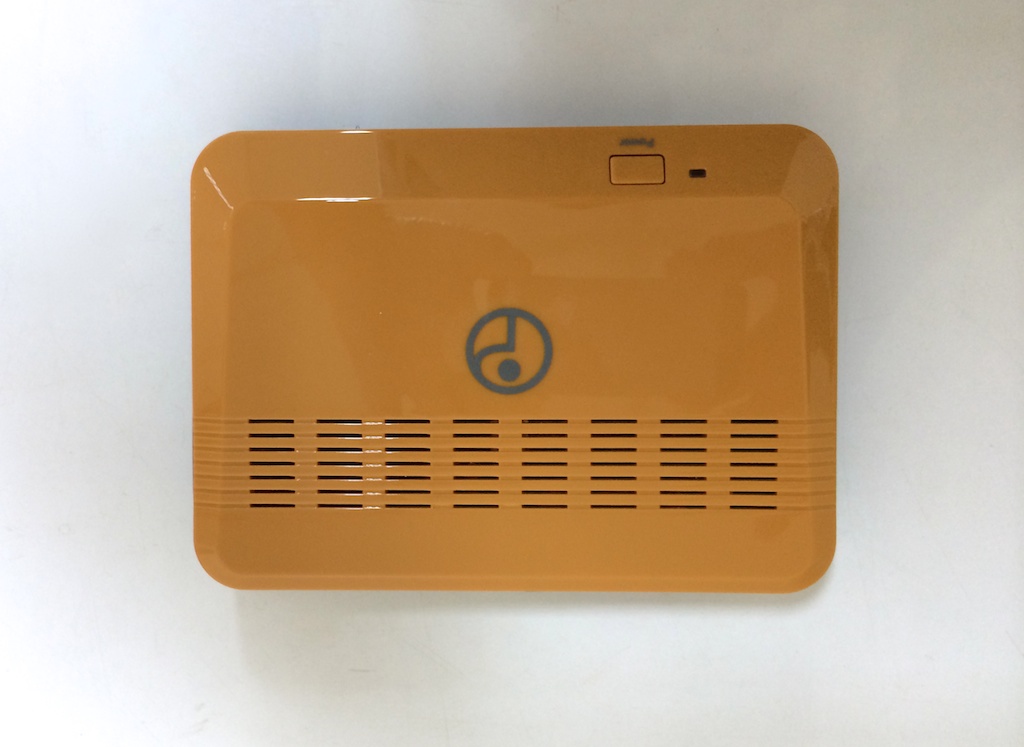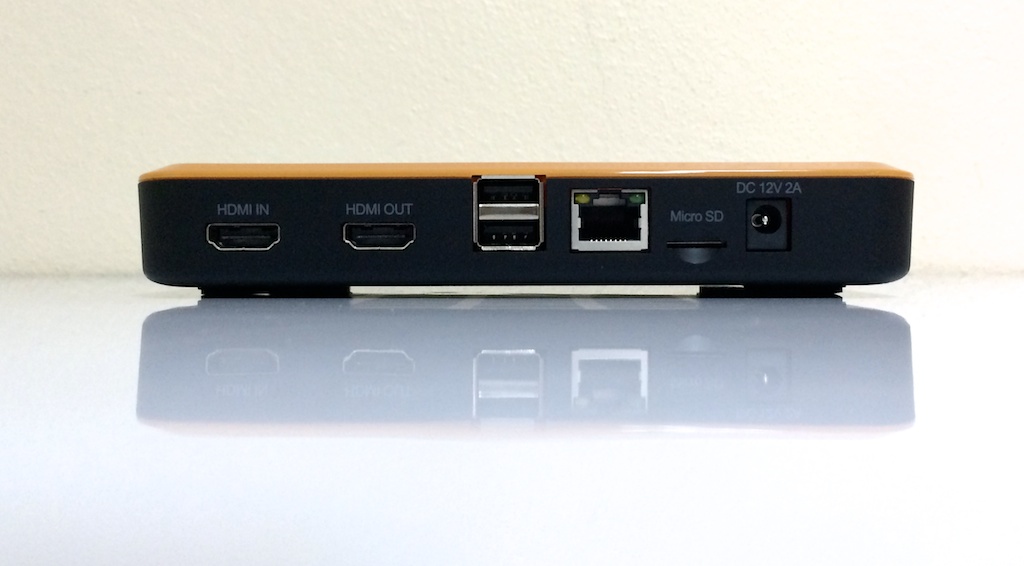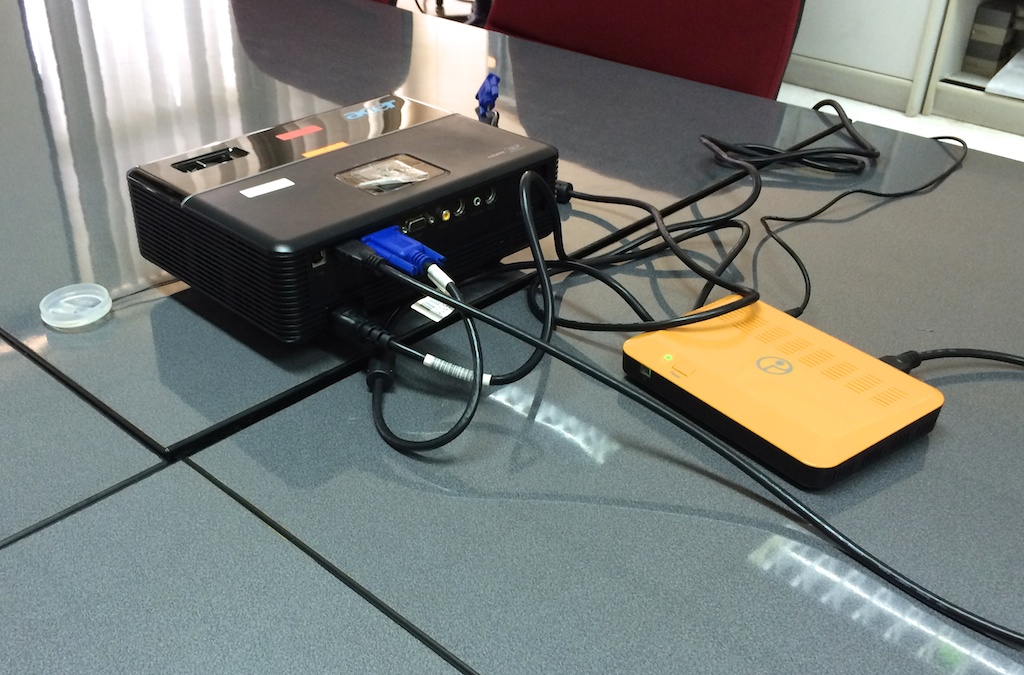Prijector: Wireless Connection of Computers to Projection Media - Needs Some Refining

AMITIAE - Monday 4 March 2014
|
Prijector: Wireless Connection of Computers to Projection Media - Needs Some Refining |
 |
|
|
By Graham K. Rogers
BackgroundIt is less easy when visiting a conference hall for the first time, or if going to a company's offices to make a sales pitch. There are always differences, whether it be with screen resolution or with the connectors themselves, there is no 100% guarantee that all equipment will behave itself, all of the time.As an example of this, the movie Flight shows a scene in which an NSBT officer conducting a crash investigation makes a couple of presentations, but when switching to a further one, is forced to move to the computer to make things work manually. This is not an unlikely scenario by any means. To remove some of the risk, I try to set up early if I can. What happens on my monitor at home, may not be the same on the projectors at a conference center.
PrijectorA new development for those who make presentations often is the projector linking device called Prijector. With the wifi that is on-board, a user can sure that connections will work without being directly anchored to the screen medium and have a reasonable distance between the devices without miles of underfoot cables. It also allows projection of a presentation (or other medium) directly to computers in the vicinity. That was the theory behind Prijector anyway. . . .

Although there was no printed manual included, earlier emails had provided a link to an online version of the manual. I was also able to track this down on the Prijector site. There was a slight contradiction with the online information as the main page includes the information, "No VGA, no DVI. . ." but a little lower down the page: "Prijector Connects to either TV Screens or projectors through HDMI or VGA". When I examined the device, I saw there was no VGA port. The screen shots on the webpage do not show VGA, but in the end, one of the tested projection devices was able to use this. Although the video graphics array (VGA) technology is old in the tooth and has begun to be replaced by superior technologies, there are still a lot of classroom (and conference) projectors that use this. While my home TV has HDMI ports, the projectors in classrooms I use do not. I was able to pick up an ASUS HDMI to VGA adapter (350 baht) in a branch of Bananarama in Pinklao, Bangkok, but was told this was the last they had. The Prijector device itself did not feel substantial as I held it. I hate the color (personal): a sort of mustard/orange. This would look much better in red or black. The base is a matt black. At the front is an infrared port (for remote control) behind translucent plastic. Left and right sides have vents. I found that it becomes fairly warm when running. The ports are on the back. From left to right these are: HDMI in, HDMI out, 2 x USB ports (there is no information as to USB version), Ethernet port, MicroSD, Power connector. On top of the device is a power button, which gives a firm click (it needs to be pressed for a couple of seconds) and a power light: green On; Red Off with power connected.

TV: HDMI and VGA (1)With my Apple TV, the Prijector is redundant at home. The Apple device allows me to connect from the Mac to the television via Wi-Fi. I am then able to run a presentation, as well as having access to other media (movies, photographs, as well as OS X and the desktop. This gave me a basis for comparison. I removed the HDMI cable for the Apple TV and connected the Prijector cable, then turned on the device.
Once running, the screen was shared between the Mac and the TV, but it was slower than when I use Apple TV and the zoom - Control+ 2 finger slide on the trackpad - was not available. This zoom feature (turned on in System Preferences - Accessibility) is essential, when explaining some things in a classroom. As well as some basic app windows, I displayed some photographs in Aperture. The images looked really good on the TV screen (as they should) but the delay when switching to each following image was far too long: 3 - 6 seconds. A video (mp4) played full screen on the Mac but froze on the TV screen: data was not being transfered at a fast enough speed. With Keynote - an essential with this type of device - the option to turn off display mirroring was not available, so I was unable to use the Presenter's Display option. I confirmed that with the AppleTV, the Mac would have a much shorter delay when showing images or changing presentation slides: less than one second. For presentations, using AppleTV, I was able to turn mirroring off and access the presenter display feature. As an alternative, I tried the VGA port that my TV has, with the HDMI to VGA connector I had bought. Nothing was displayed. Connecting the Mac to the TV (HDMI - adapter - VGA port) also showed no picture. Connecting the Mac via the Thunderbolt port and the Apple video-VGA adapter (my normal method) did give me a TV display.
VGA (2)At my office, I have an ACER 17" monitor with DVi-D and VGA ports. I often use this with the Mac. When I turned the monitor on, it displayed a panel with "Cable not connected", but when I plugged the HDMI - VGA adapter in without turning on the Prijector, this changed to "No signal". I was hopeful.When the power was turned on, the Prijector screen was displayed. I switched to the Prijector Wifi signal and started the sharing software, but was asked for a validation code. As the wifi was connected, that appeared OK, but what the validation code was, I had no idea. Restarting the power displayed the screen saver again, but there was still no information as to what data I should be entering. I restarted the Prijector software and this time, the correct screen appeared and I was able to press Share, but nothing appeared on the monitor. I restarted the sharing software, but this time the panel showed nothing. I restarted all devices again, but still was unable to display anything on the VGA monitor.

Projector: HDMI and VGA (3)We do have an Acer projector at the department that has HDMI as well as the usual VGA ports. I connected the Prijector to the projector in the same way as I had to the TV at home. The results were the same, although the screen projection was larger of course. The same time delays as I had experienced with the TV occurred here (between 3 - 6 seconds) and there was no access to turn off display mirroring. The second display did not appear in System Preferences.However, this device was able to use the VGA connection, albeit with the same delays between action on the computer and seeing the screen display change. As with the direct HDMI connection on this Acer projector, the second display did not appear in System Preferences and therefore I could not turn off display mirroring. The Control+ 2 finger slide on the trackpad was not available at all when using this Acer projector: as before, the Mac screen changed (zoom) but the projector screen did not. I connected a mouse to the Prijector using one of the USB ports. On the Prijector display that appeared when the device was restarted on the power button, there were a number of options available to fine-tune the device. Settings include Wifi, Ethernet, Display, (Wallpaper, Resolution, Overscan ratio and Font size). With the Wifi setting, I had the option to join one of the available networks, which would mean devices could access the facility, without needing to join the Prijector wifi. Like using the facility for remote projection, mouse movements and reactions were slower than (I feel) is usual.
CommentsThese initial tries with the Prijector, suggested that this was more limited than the normal connections that I use - Apple TV, cable - and was more limited than I had expected. Nonetheless, I would be able to go into a location with the device and connect directly with a TV, so all is not lost. My main criticisms are that the displays were limited (mirroring, zoom) and the transfer speeds were slower than I would have hoped.The device works with a number of operating systems, including Windows. I did note that the software for the Mac was up to date and made references to OS X 10.9 (Mavericks). There are also plans to make this available to iOS and Android devices. As I do many of my presentations from the iPhone and sometimes from an iPad, this would be welcome. There is potential, but it needs refining.
Graham K. Rogers teaches at the Faculty of Engineering, Mahidol University in Thailand where he is also Assistant Dean. He wrote in the Bangkok Post, Database supplement on IT subjects. For the last seven years of Database he wrote a column on Apple and Macs. |
|

For further information, e-mail to

|

|